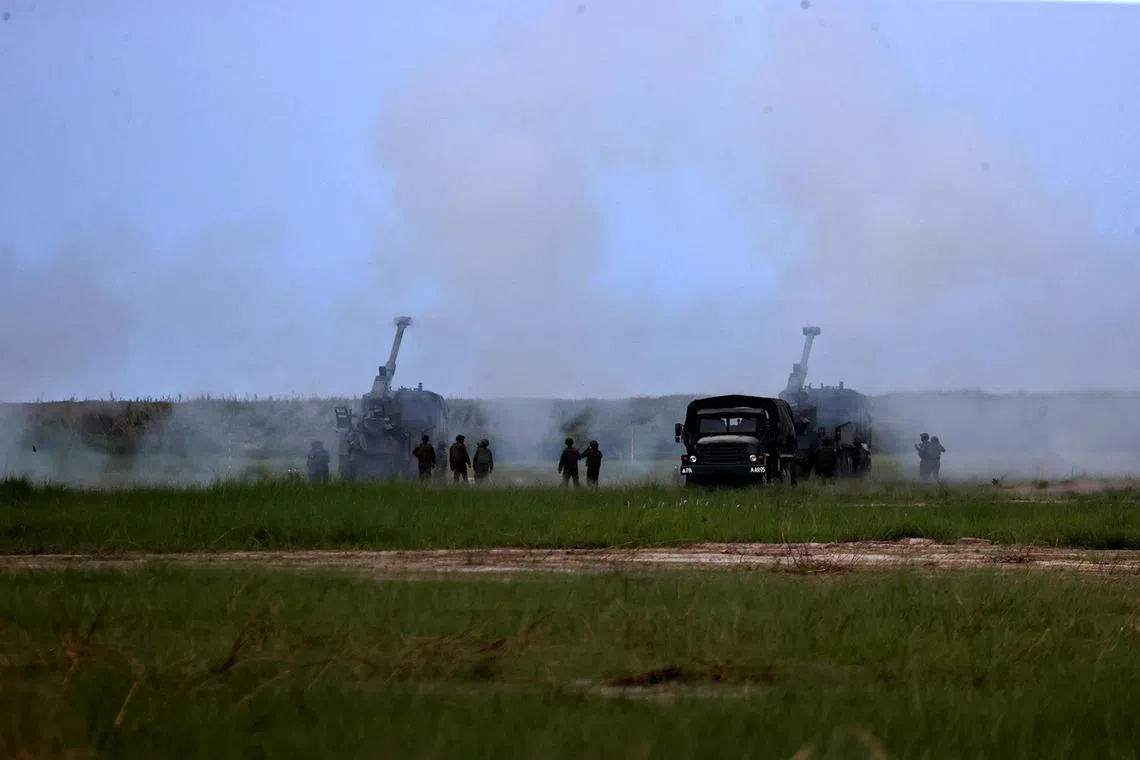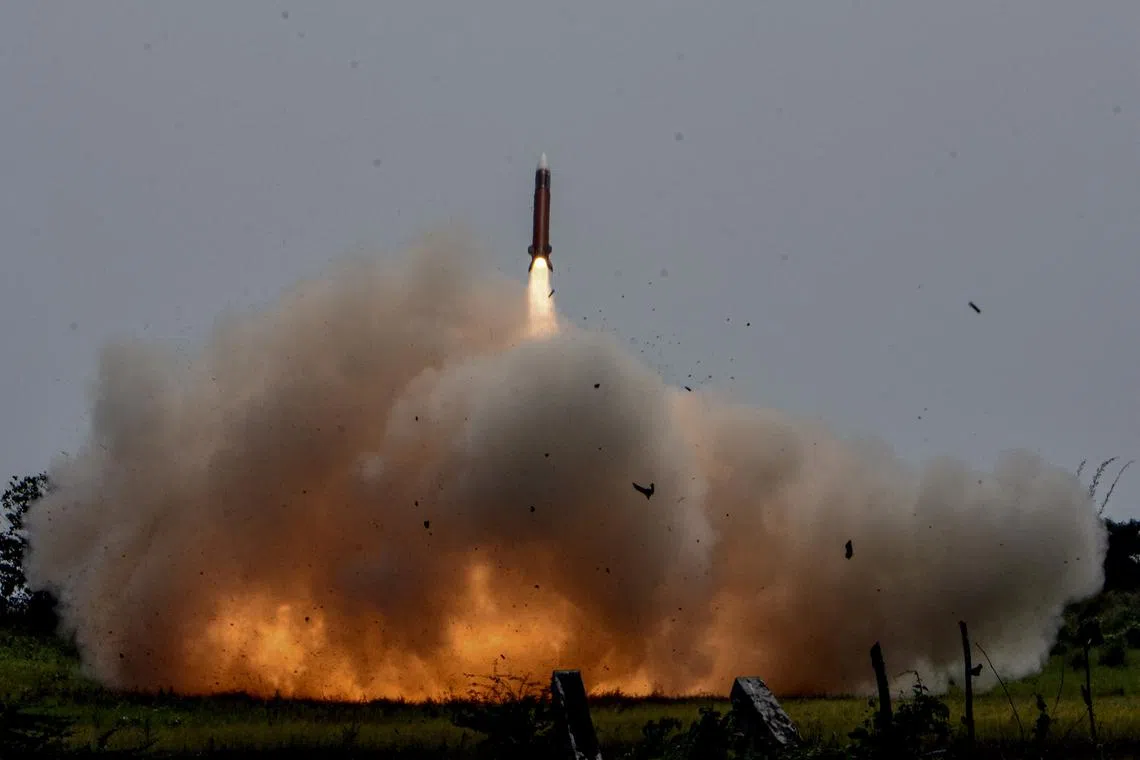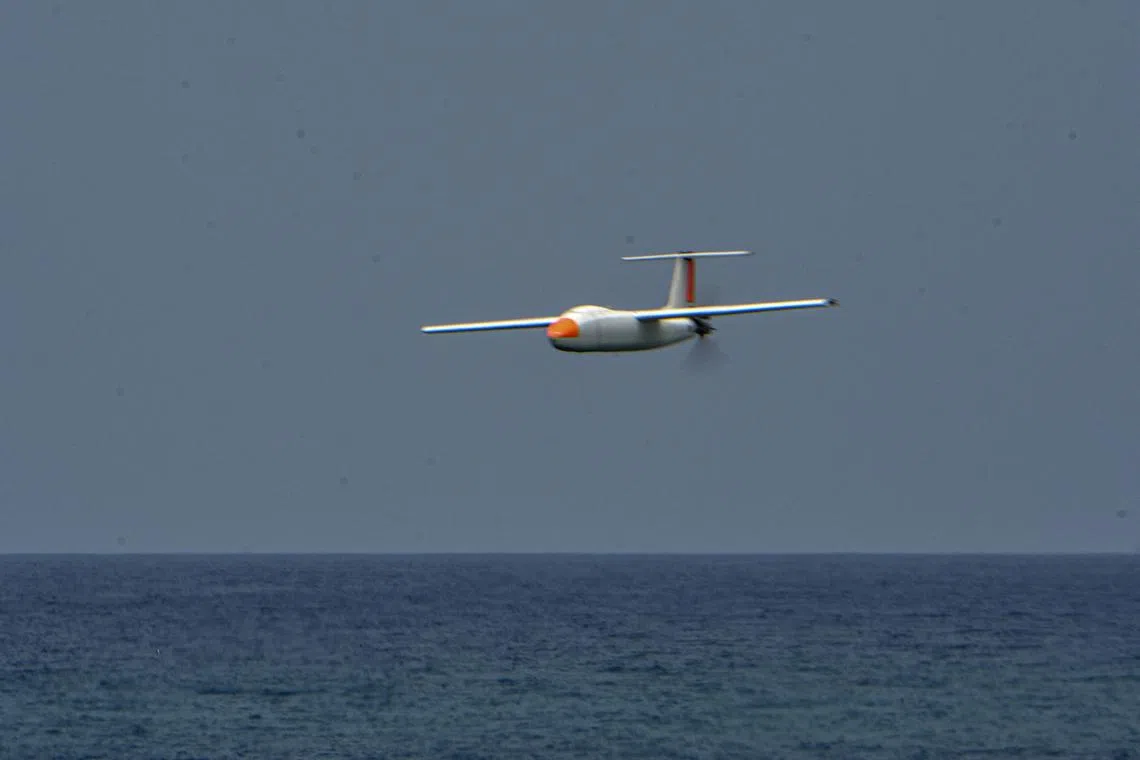US, Philippines sink mock enemy ship in their largest South China Sea drills
Sign up now: Get insights on Asia's fast-moving developments

A missile is fired by a US Himars precision rocket system during the US-Phiippines war games in Zambales on April 26, 2023.
ST PHOTO: ANGIE DE SILVA
Follow topic:
ZAMBALES, Philippines – United States and Philippine military forces on Wednesday fired a volley of missiles and bombs to sink an old Philippine Navy warship representing an enemy vessel in the disputed South China Sea, the highlight of the largest war games yet between the two nations.
This is the first time Manila and Washington have simulated a sea attack and carried out a rocket bombardment exercise in the waterway, where the Philippines and China have competing claims.
The decommissioned BRP Pangasinan sank some 20km off the coast of Zambales at 2.55pm.
“Ex-BRP Pangasinan completed its final journey. Credit goes to the United States’ F-35 using a laser-guided bomb unit,” Colonel Michael Logico, spokesman for Exercise Balikatan, told The Straits Times.
Philippine President Ferdinand Marcos Jr, flanked by US Ambassador to the Philippines MaryKay Carlson and Manila defence chief Carlito Galvez Jr, watched most of the nearly six-hour-long drills from an observation tower near the shore.
But Mr Marcos left for another engagement before the troops could sink the ship.
It is rare for Philippine presidents to grace the annual Balikatan war games, now in their 38th year. The live-fire drills also came five days before Mr Marcos is set to fly to the US
Mr Marcos’ presence sends a strong political message to China, said maritime security expert Collin Koh of Singapore’s S. Rajaratnam School of International Studies.
“This demonstrates that the Philippines-US military alliance, as well as such bilateral defence activities, has the full backing of the top political and defence leadership,” Dr Koh said.
Mr Marcos’ presence at the live-fire exercise also further highlights the President’s departure from predecessor Rodrigo Duterte’s China-friendly foreign policy.

Philippine President Ferdinand Marcos Jr observes the joint live-fire drills in the disputed South China Sea on April 26, 2023.
PHOTO: PHILIPPINES PRESIDENTIAL COMMUNICATIONS OFFICE
Mr Marcos is, instead, striking a balance between boosting defence ties with the US to help counter Beijing’s military might, and fostering economic relations with China.
Manila’s multi-role guided missile frigate BRP Jose Rizal was the first to fire on the ship.
Then six rounds of missiles from a US Himars precision rocket system were fired at the decommissioned Philippine Navy ship.
But the drills were interrupted for close to an hour after an unregistered civilian plane entered the live-fire airspace.
After the drills resumed, light attack aircraft from both Manila and Washington bombed the mock enemy ship, with a US F-35 dealing the final blow.
The live-fire drills also featured land-based artillery units and a Bell AH-1 Cobra helicopter firing rockets at floating targets offshore.

Filipino and US troops use artillery units to fire at floating targets offshore during the Balikatan war games in Zambales, Philippines on April 26, 2023.
ST PHOTO: ANGIE DE SILVA
These were meant to display both nations’ maritime defence capabilities as tensions simmer with Beijing in the South China Sea and Taiwan Strait.
But Col Logico maintained that the drills were not directed at a particular country.
“The reason we are doing an exercise of this magnitude is because we are exercising or demonstrating our ability to be interoperable with our US counterparts, which are also our treaty ally,” he said.
Balikatan means “shoulder to shoulder” in Tagalog. The war games will run until Friday.
This year’s Balikatan is the largest yet, with more than 17,600 US and Filipino military personnel holding joint exercises across different parts of the country since April 11.
Australia sent 100 troops, while allied nations such as Japan and Britain dispatched military observers.
The annual war games are being held in key areas in the Philippines, including the provinces of Zambales and Palawan, whose coastlines are just hundreds of kilometres away from the South China Sea and Taiwan.
On Tuesday, the Balikatan exercises in Zambales also saw in action Patriot missiles, the US’ state-of-the-art missile system currently being used by Ukraine in resisting Russia’s invasion.

A Patriot missile in flight to intercept an identified enemy aircraft at the Balikatan military exercise in Zambales, on April 25, 2023.
ST PHOTO: ANGIE DE SILVA
“You’ll see around the globe where our US Patriot forces operate, and not just here in the Indo-Pacific, the recognition that this system is lethal, combat-credible, has a history in crisis, conflicts and peace, to both assure and deter,” Major-General Brian Gibson of the US Army Air Forces told reporters in Zambales.
Dr Koh said using these missile systems during Balikatan is even more crucial after Manila earlier in April gave the US wider access to Philippine military bases

A cruise missile surrogate is deployed during Exercise Balikatan in Zambales, on April 25, 2023.
ST PHOTO: ANGIE DE SILVA
Three of the additional military sites covered by Edca are in two northern Philippine provinces that are only hundreds of kilometres from Taiwan. A fourth additional site was named in Palawan, an island province facing the South China Sea.
This gives the US access to a total of nine Philippine military bases.
China was displeased with the Edca expansion and warned Manila it could get dragged into the tensions with Taiwan.
“Seen in the context of the upcoming meeting between Marcos and Biden, during which the former will be asking the latter to further clarify defence commitment under the Mutual Defence Treaty (MTD), this exercise demonstrates American commitment to this alliance,” said Dr Koh.

This year’s Balikatan is the largest yet, with more than 17,600 American and Filipino military personnel holding joint exercises.
ST PHOTO: ANGIE DE SILVA
The 1951 MTD between the US and the Philippines prescribes both nations’ commitment to defend each other in the event of an armed attack by a hostile party.
Sought for comment on Balikatan, Chinese Foreign Ministry spokesman Wang Wenbin said on Wednesday that cooperation between relevant countries should not target any third party, and must be conducive to regional peace and stability.
“The US-Philippines military cooperation must not interfere in South China Sea disputes, still less harm China’s territorial sovereignty, maritime rights and interests and security interests,” he said.


